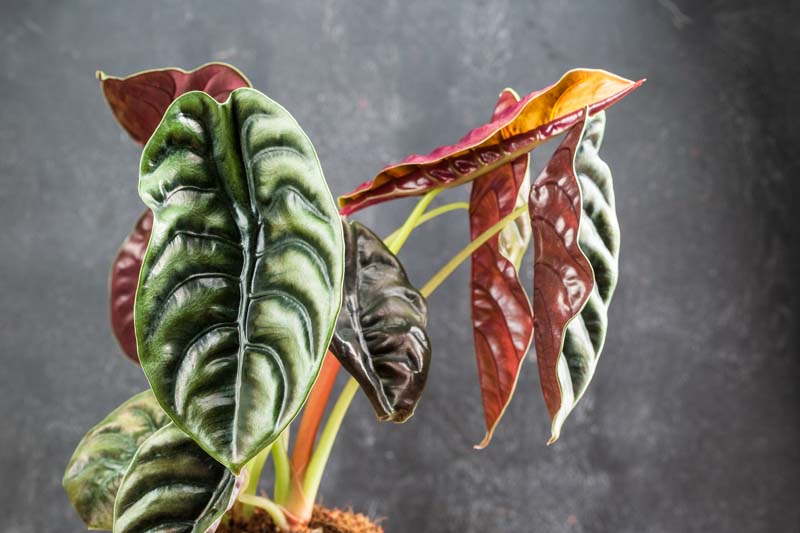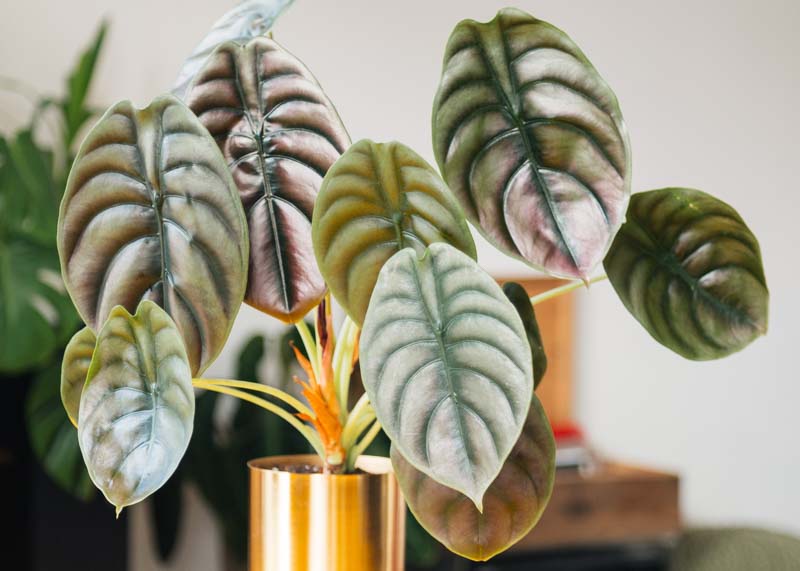Elephant Ear ‘Red Secret’, Alocasia 'Red Secret'
Alocasia cuprea ‘Red Secret’ is a mesmerizing variety of Alocasia, highly prized for its unique, metallic-looking foliage that captures the eye and sparks the imagination. This plant, with its compact growth and stunning visual appeal, makes a dramatic statement in any indoor plant collection.
Alocasia cuprea ‘Red Secret’ is notable for its extraordinary leaves that boast a metallic sheen, appearing almost coppery or bronze with a mix of deep red and green hues. The leaves are thick, rigid, and have a distinct texture that enhances their iridescent quality.
Native: This variety is part of the Alocasia genus, which originates from the tropical rainforests of Southeast Asia. Alocasia plants are known for their striking foliage and are native to areas that provide a warm and humid environment. Alocasia belongs to the Araceae family, commonly known as the Arum family. This diverse family includes other well-known plants like Zantedeschia (Calla Lily), Caladium (Angel Wing), and Monstera (Swiss Cheese Plant).
Plant Type and Habit: It is a tender perennial that exhibits an upright and somewhat compact growth habit. This characteristic makes it well-suited for indoor cultivation, where its exotic appearance can be fully appreciated.
Size: Alocasia cuprea ‘Red Secret’ remains relatively modest in size compared to other Alocasia species, typically reaching about 1-2 feet (30-60 cm) in height and spread. Its compact nature makes it an ideal choice for smaller spaces or as a desktop plant.
Flower: While it can flower, producing a spadix surrounded by a pale spathe, the blooms are infrequent and not the main attraction. The plant is grown primarily for its stunning foliage.
Foliage: Each leaf is a work of art, starting as glossy, oval-shaped canvases that can grow up to 24 inches (60cm) in length. When young, the leaves boast a vibrant red flush that captivates the eye. As they mature, they undergo a stunning transformation, with the upper surface becoming a rich tapestry of dark green and coppery bronze hues. This metallic sheen, reminiscent of beaten copper, gives the plant its common name and makes it a coveted specimen among plant enthusiasts.
The underside of each leaf contrasts dramatically with the top, featuring a deep red hue that adds to the plant’s exotic allure. Adding to its unique appearance, the texture of the leaves is rippled, with deeply indented veins creating a visual and tactile experience that is unparalleled.
Hardiness: Best suited for USDA hardiness zones 10-12, Alocasia cuprea ‘Red Secret’ is not frost-tolerant and thrives in warm, humid environments, typical of its tropical origins.
Uses: ts striking appearance makes Alocasia cuprea ‘Red Secret’ a perfect ornamental plant for indoor gardens, terrariums, and as part of a mixed plant display. It is often used to add a touch of the tropics and visual interest to home and office spaces.
Toxicity: Alocasia plants are toxic if ingested. They contain calcium oxalate crystals that can cause irritation of the mouth, throat, and stomach in humans and pets.
Benefits: Like many houseplants, it can help improve indoor air quality by filtering airborne toxins.

Growing and caring for Alocasia cuprea ‘Red Secret’ involves meeting its specific needs for light, water, and humidity. With the right conditions, this plant can thrive both indoors and outdoors.
Light: Alocasia cuprea ‘Red Secret’ thrives in bright, indirect sunlight. Too much direct sunlight can scorch its leaves, while too little light can cause leggy growth. Place it near a window with sheer curtains to filter the light or in a room with ample ambient light.
Water: Keep the soil consistently moist but not waterlogged. Water when the top 1-2 inches of soil feel dry to the touch. Overwatering can lead to root rot, so ensure your pot has good drainage.
Humidity: This plant loves high humidity, reflecting its tropical origins. Regular misting, a pebble tray with water, or a humidifier near the plant can help maintain the moisture levels it loves.
Temperature: Alocasia cuprea ‘Red Secret’ prefers warm conditions, ideally between 65°F to 75°F (18°C to 24°C). Avoid placing it near cold drafts or heating vents.
Soil: Use a well-draining, peat-based potting mix. The soil should be fertile and slightly acidic to neutral.
Fertilization: Feed every 4-6 weeks during the growing season with a balanced liquid fertilizer diluted to half strength. Do not fertilize in the winter when growth slows.
Climate: Alocasia cuprea ‘Red Secret’ can be grown outdoors in USDA zones 10-12. In cooler climates, it’s typically grown in pots and brought indoors when temperatures drop.
Light: Similar to indoor care, it prefers a spot that receives bright, indirect light or partial shade. Direct afternoon sun can be too intense and burn the leaves.
Soil: Plant in rich, well-draining soil. If your garden soil is heavy, amend it with organic matter to improve drainage and fertility.
Watering: Outdoor plants may require more frequent watering than indoor ones, especially in hot, dry conditions. Ensure the soil remains moist but not soggy.
Humidity: While outdoor plants are generally in more humid environments than indoor ones, those in dry areas might still benefit from occasional misting.
Protection: In areas with occasional cold spells, be prepared to cover your Alocasia or move it indoors to protect it from frost.

Propagating Alocasia cuprea ‘Red Secret’, like many Alocasia species, is most effectively done through division. This process involves separating the plant’s rhizomes (underground stems) to create new plants.
Best Time for Propagation: The ideal time to propagate Alocasia cuprea ‘Red Secret’ is in the spring or early summer when the plant is entering its active growth period. This gives the divisions a better chance to establish themselves before the colder months.
Prepare the Parent Plant: Water the plant a day before you plan to divide it to ensure the soil is moist and the plant is hydrated.
Remove the Plant from Its Pot: Gently take the Alocasia cuprea ‘Red Secret’ out of its pot, being careful not to damage the roots. If the plant is grown outdoors, carefully dig around the plant to lift it from the soil.
Clean Off the Soil: Gently remove as much soil as possible from around the roots so you can clearly see the rhizome and root structure.
Identify Division Points: Look for natural divisions in the rhizome. Each division should have at least one growth point (node) and some roots.
Divide the Rhizome: Using your clean, sharp knife or shears, cut the rhizome into sections, making sure each section has at least one growth point and a portion of the roots.
Pot the Divisions: Plant each division in its own pot filled with well-draining potting mix. The pot size should be appropriate for the size of the division, not too large to prevent excess moisture around the roots.
Care for the New Plants: Water the newly potted divisions lightly to settle the soil around the roots. Place them in a location where they will receive bright, indirect light. Maintain high humidity around the plants, using a humidifier or placing the pots on a tray of pebbles and water to increase ambient moisture.
Aftercare: Keep the soil consistently moist but not waterlogged. Maintain high humidity to support the new plants’ growth. Avoid direct sunlight to prevent leaf scorch.
While stunning, Alocasia plants can encounter several pests, diseases, and common problems, especially when their growing conditions are not optimal.
Spider mites: These tiny pests thrive in dry conditions and can cause the foliage to look dull and stippled. Increase humidity and wash the plant with water. In severe cases, use insecticidal soap or neem oil.
Mealybugs: Recognizable by their cotton-like white masses, they suck plant sap, weakening it. Remove them manually using a cotton swab dipped in rubbing alcohol or apply insecticidal soap.
Aphids: These small, green pests suck sap from new growth. Rinse them off with water or treat the plant with neem oil.
Scale insects: These can appear as small brown bumps on the stems and leaves, sucking the sap and reducing plant vigor. Scrape them off or treat them with neem oil.
Root rot: Overwatering is the primary cause, leading to soggy soil conditions where fungi thrive. Ensure the soil is well-draining and reduce watering frequency.
Leaf spot: Fungal and bacterial infections can cause spots on leaves. Improve air circulation, avoid wetting foliage when watering, and remove affected leaves. Fungicides may be required in severe cases.
Yellowing Leaves: Over- or underwatering can lead to yellow leaves. Adjust watering practices to ensure the soil is moist but not waterlogged.
Drooping Leaves: This can be a sign of either too much or too little water, extreme temperatures, or inadequate light. Assess the growing conditions and make necessary adjustments.
Brown Leaf Edges: Low humidity or salt build-up from fertilizers can cause crispy edges on leaves. Increase humidity around the plant and flush the soil with water periodically to remove excess salts.
| Hardiness |
10 - 12 |
|---|---|
| Plant Type | Houseplants, Perennials |
| Plant Family | Araceae |
| Genus | Alocasia |
| Common names | Elephant Ear |
| Exposure | Partial Sun |
| Season of Interest |
Spring (Early, Mid, Late) Summer (Early, Mid, Late) Fall Winter |
| Height |
1' - 2' (30cm - 60cm) |
| Spread |
1' - 2' (30cm - 60cm) |
| Spacing |
12" - 24" (30cm - 60cm) |
| Maintenance | Low |
| Water Needs | Average |
| Soil Type | Loam, Sand, Chalk |
| Soil pH | Acid, Neutral |
| Soil Drainage | Moist but Well-Drained |
| Characteristics | Showy, Evergreen |
| Garden Uses | Patio And Containers |
| Garden Styles | Mediterranean Garden |
| Hardiness |
10 - 12 |
|---|---|
| Plant Type | Houseplants, Perennials |
| Plant Family | Araceae |
| Genus | Alocasia |
| Common names | Elephant Ear |
| Exposure | Partial Sun |
| Season of Interest |
Spring (Early, Mid, Late) Summer (Early, Mid, Late) Fall Winter |
| Height |
1' - 2' (30cm - 60cm) |
| Spread |
1' - 2' (30cm - 60cm) |
| Spacing |
12" - 24" (30cm - 60cm) |
| Maintenance | Low |
| Water Needs | Average |
| Soil Type | Loam, Sand, Chalk |
| Soil pH | Acid, Neutral |
| Soil Drainage | Moist but Well-Drained |
| Characteristics | Showy, Evergreen |
| Garden Uses | Patio And Containers |
| Garden Styles | Mediterranean Garden |
How many Alocasia cuprea ‘Red Secret’ (Elephant Ear) do I need for my garden?
| Plant | Quantity | |
|---|---|---|
| Alocasia cuprea ‘Red Secret’ (Elephant Ear) | N/A | Buy Plants |
Create a membership account to save your garden designs and to view them on any device.
Becoming a contributing member of Gardenia is easy and can be done in just a few minutes. If you provide us with your name, email address and the payment of a modest $25 annual membership fee, you will become a full member, enabling you to design and save up to 25 of your garden design ideas.
Join now and start creating your dream garden!
Create a membership account to save your garden designs and to view them on any device.
Becoming a contributing member of Gardenia is easy and can be done in just a few minutes. If you provide us with your name, email address and the payment of a modest $25 annual membership fee, you will become a full member, enabling you to design and save up to 25 of your garden design ideas.
Join now and start creating your dream garden!